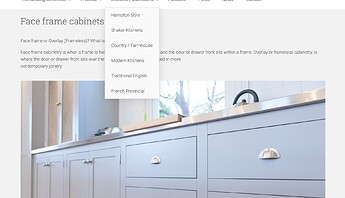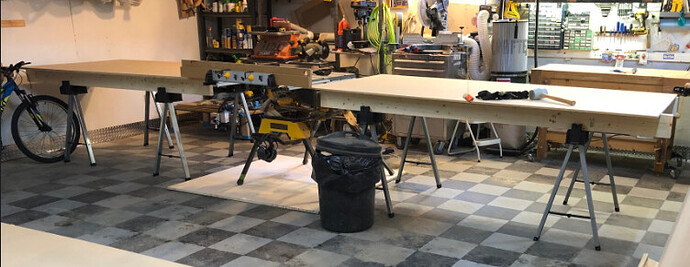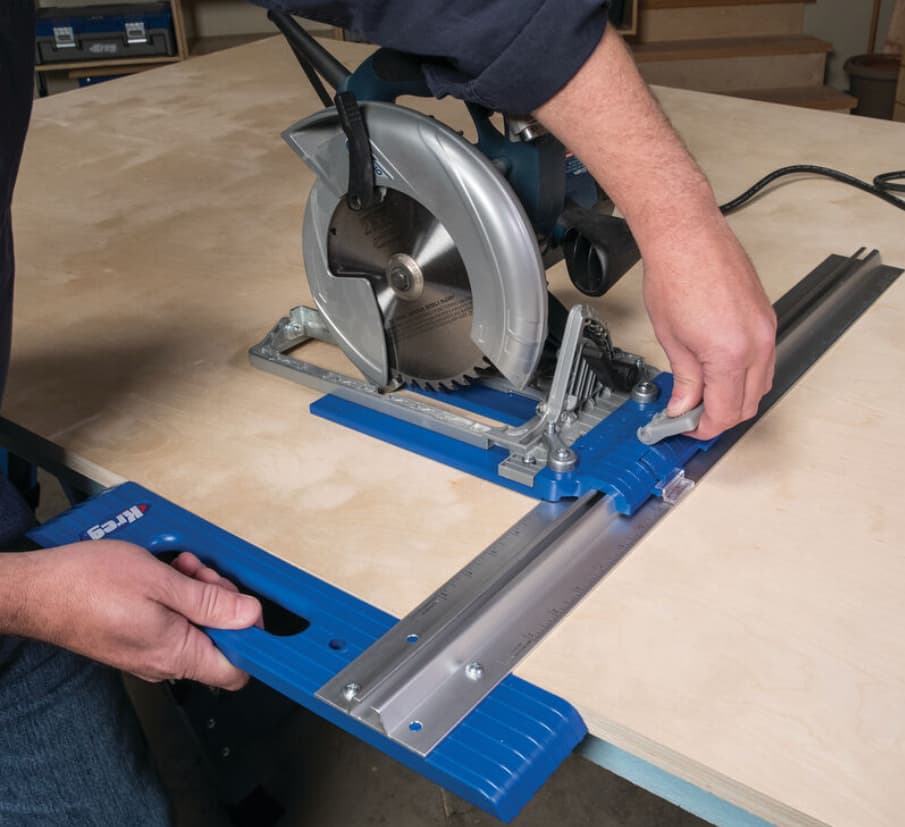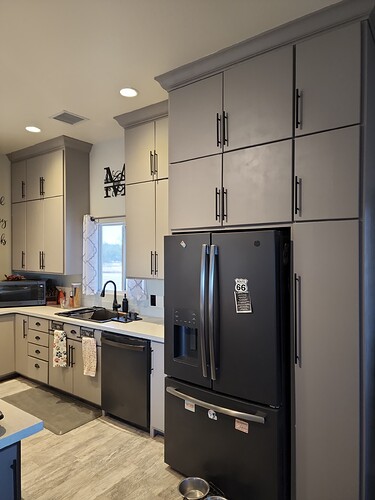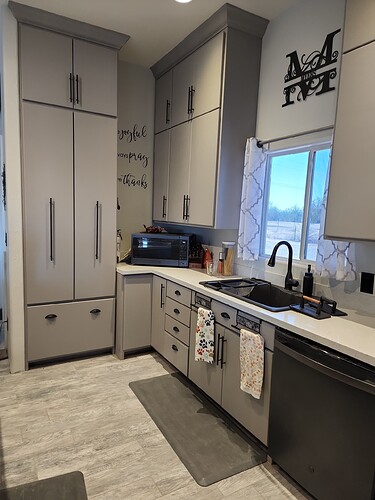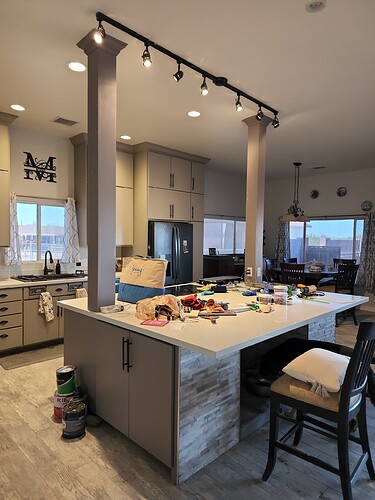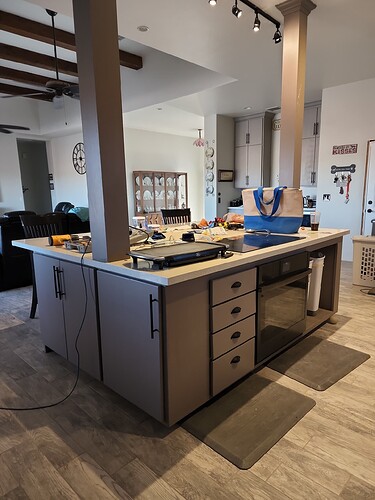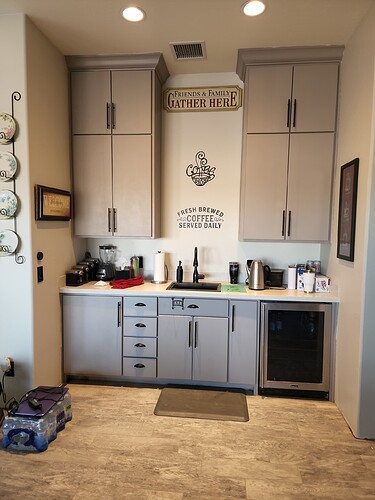It’s what the major hardware stores keep in stock for a slow-close option - at least in my area.
In Aus at least labour costs would get in they way - why use ten pieces of timber when you can use one sheet of 12mm MDF already laminated with a clean white finish?
The doors in the pic are one piece, with a decorative cut on the front.
Actual rail and style doors are how you make doors out of hardwood. They are stable and they use less wood (the panels are thinner). In modern manufacturing, standard sizes of doors are churned out by factories and they use that style to same a lot of material. That isn’t an american thing, is it? To me, depending on the design choices, it can invoke either “high class” or “hard working country” style. That usually comes down to a clear finish vs paint.
After you have chosen the door, the hinges are a separate decision. The european style hinges are hidden, and can do soft close. Those style of hinges are the norm for cabinets.
In this piece, this is going to be a hard working, form and function cabinet. The hinges are high on function. The doors are stable, durable, painted. The decorative element adds something to look at. It makes it more obvious there was some thought put into it, and it (to me) invokes a bit of a country style.
Seems totally reasonable. I don’t know why anyone would question it. But I am American. I wonder what is different about the rest of the world. I assumed it was common. Mostly because Ikea uses the combination a lot:
We see the same design elements here, Jeff, but Canada isn’t much different construction-wise.
A quick check though show the same style cabinet doors are available at Ikea locations, pretty much world-wide. I just kind of spot-checked a few European Ikea sites, (And Australia, for good measure) and the same stuff is available. Ikea does a lot of flat cabinet doors, too, of course.
I don’t think we’re talking at crossed purposes here - I cannot remember the last time I’ve seen a face-frame - or a cabinet that didn’t have “Euro” style hinges. I am talking utilitarian cabinets here not fancy high end stand-alone joinery pieces. The frame is redundant as the hinges can either finish with the door flush with the face of the cabinet ends or sitting proud of it.
BUT you lot have piqued my curiosity - so here comes the potted history of cabinet making in Aus as I recall it (this is from memory and if you do the sums you will realise that once people attain a certain age they have quite selective memories - so as they say “do your own research!”
I started work in an architect’s office in the (very) late 60’s which surprised me just now when I thought about how long ago that was! ![]()
Then cabinets were detailed with ex 2" x1" framing and plywood - the better quality cabinets had solid timber doors and nicer timber species.
In the very early seventies - What is now called “mid century modern” and “modern -Euro” styling but was at the time called “contemporary”, coincided (in Aus) with the increased availability of cheaper particle board materials. Cabinets were detailed with timber edge strips on raw particle board - solid timber gave way to veneered ply and particle board, and face frames were officially a thing of the past.
High end cabinets were sealed with clear, but most had raw particle board interiors, the off-gassing from which would actually cause eyes to sting when you entered a new house! They still had timber edge strips planted on the shelf faces to prevent sag and to finish off the crusty edges.
Doors were almost always flat surfaces and “concealed hinges” were knife hinges.
In the mid seventies some of the adventurous joinery shops were importing massive manufacturing plant from Germany - and that coincided with the manufacture of MDF and better automated veneering systems which brought the cost of melamine facing down to just below “expensive novelty” cost.
Things moved rapidly from there - computer manufacturing meant that everything could be cut and pre-drilled and cabinet assembly no longer needed any level of skill and the difference between low end and high end cabinets (in Aus) was really about the care that was taken in installation. Cabinet making as a skilled trade virtually disappeared.
The circle has turned now - with housing values at stupidly high rates and people apparently falling about looking for ways to spend money - this from a quick search - kitchen cabinets at TEN times the price of standard manufacture! I understand that for those of you in North America this is not unusual - but here it’s extraordinary!
For all of the above, I missed the point! ![]() Note the styles in the shot above from a “high end” Australian manufacturer - “Hampton”, “Shaker”, “Country Farmhouse” are unmistakably American - and ironically the “French Provincial” and “Traditional English” styles are too, and in this context are marketing terms!
Note the styles in the shot above from a “high end” Australian manufacturer - “Hampton”, “Shaker”, “Country Farmhouse” are unmistakably American - and ironically the “French Provincial” and “Traditional English” styles are too, and in this context are marketing terms! ![]()
In the 80’s large wood manufacture’s went full speed on the 32mm system. Everything from cutting to edge banding, and case construction. I sold a lot of older equipment back then that didn’t “fit the system”. It was viewed as the most cost effective way to mfg. modular based cabinetry.
[quote=“ddbuster, post:27, topic:33045”]
32mm system
[/quote] Can you explain that? Our carcasses are usually 16 mm with standard tops at about 32 I suspect that this came about because everything was once 3/4 (19mm), and it just crept down to the minimum that would do the job. The tops were originally the same as the panels with a thickening on the edges, but it was just more economical (less labour) to make them out of a thicker panel.
Here’s a link that spells it all out much better than I could. Just remember, everything revolves around 32mm one way or another.
Yep. Even Ron Paulk’s new workbench is based off the 96mm standard.
EDIT
No need to read the rest of my conspiracy theory - I found the origin
Not at all relevant in today’s world IMHO, but here you go!
END EDIT
Thanks for the link and the info. Here’s Australia’s response to that! ![]()
![]() Australian Standard Kitchen Dimensions | RENOMART
Australian Standard Kitchen Dimensions | RENOMART
Now I’ve gone on a mad measure round the house - our Aus built cupboards have shelf pins at 48mm which some would say was 1.5 times 32 - but is actually exactly divisible into 2400, the size of a metric sheet. Blum hardware does indeed have some screws 32 apart, and others that are 42, 48 and 52, and Hafale is similar.
Ikea shelf pins are 32mm but the hardware varies.
None of that makes sense to me since economy comes in multiples of sheet size and there are no economies at 32mm that I can see, and a computer can tell a machine to drill a hole where ever it wants?
And then I realised that 32mm is almost exactly 1 1/4 inch which is exactly divisible into an 8’0" sheet (and not a 2400 one), but 32mm isn’t. (Maths is not my strength so please take with a grain of salt) Curiously 32mm x 76 times plus 5mm for the width of one hole = 2437 or exactly not quite 8’0" or 2440 either. Is this actually a Euro standard, or something curiously made up? I am sensing a monstrous conspiracy here, perhaps the 5G rays have finally got to me.
What sort of a cliff have you just pushed me over! ![]()
Late to the party but I wouldn’t recommend a CNC for straight cuts on sheet goods unless you are doing more complicated cuts at the same time. dewalt makes an excellent contractor’s table saw with legs that fold up tiny enough to tuck into a pretty small space. I’m really happy with mine. Some 2x4s you can setup temporary feed tables and tackle just about anything. This all packs down small enough to go under a workbench (or low rider table) easy. They’ve been out for awhile so I’ve seen them used cheap. Also, instead of a table saw for cutting stock Kreg makes a really good circular saw attachments I use mine all the time for very long cuts with a piece of foam on the floor it’s more convenient and accurate (a couple hundredths of an inch).
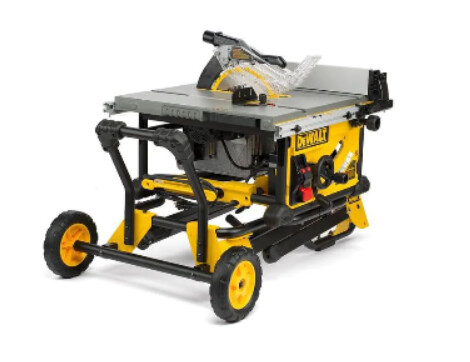
Let’s say I’m buying prefinished 3/4" baltic birch.
Making some cabinet doors.
I cannot fine-tune a dewalt saw enough, i cannot spend enough on blades, i cannot alter my technique enough to avoid chipping on the bottom side without sacrificial boards.
You say no to cnc for straight cuts? I say you can’t cut melamine on your dewalt, let alone veneer.
I use a similar saw. They are very adjustable but not easily so and cut very accurately once calibrated and stabilized.
You need a special blade to cut melamine without a sacrificial board or tape. Technique won’t cover for the wrong cutter.
Not when your comparing it to a machine designed specifically to make straight cuts.
Clearly not true. A calibrated saw, a clean sharp blade, and resisting the urge over-feed will have those panels cut before the CNC is even programmed.
I cut a heck of a lot of 3/4" Cherry Veneer plywood on a craftsman contractors saw when I did my kitchen.
Freud 80 tooth blades, blue tape and I sweated every cut 
Did I have absolutely zero tearout? Heck no, I was doing this on equipment that cost less than the plywood in my driveway. But after 20+ sheets of ply there were only a couple of crosscuts I wish I could take back.
Was it minimal and acceptable. Absolutely.
Speaking of saws if y’all are interested I have (3) Hendrick 60" vertical panel saws and a 128" Hendrick CNC panel saw in stock priced to sell. These are commercial saws, not your typical saw for home but…
A full sheet Lowrider is capable of milling quality cabinets. Except for the popular face frames, my cabinets were milled from 3/4 Birch plywood on my Lowrider.
Glad to see you popped in. And folks, I’ve seen this kitchen in person. It’s an absolute testament!
wow very nice!
Very nice beautifully done  are they individual boxes?
are they individual boxes?
Tom, that is beautiful work.
What is the motivation for using the CNC vs a table saw?
I am not arguing, I am just trying to figure out which reasons motivated someone who has actually done it.
